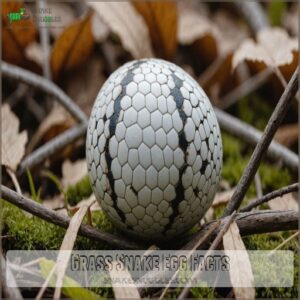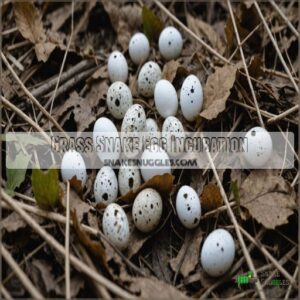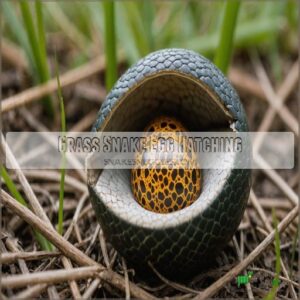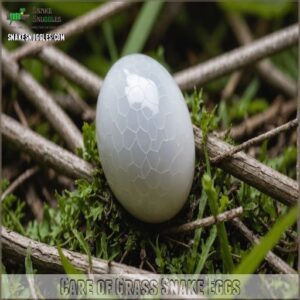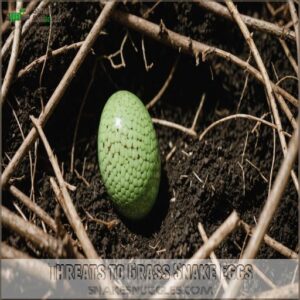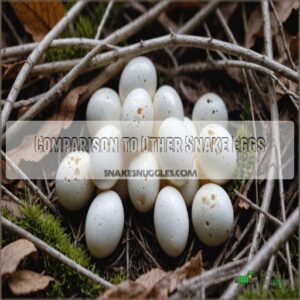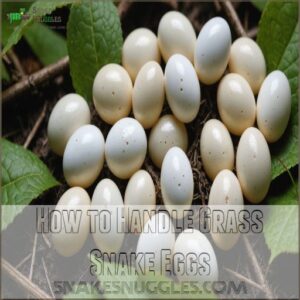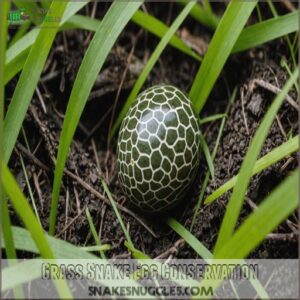This site is supported by our readers. We may earn a commission, at no cost to you, if you purchase through links.
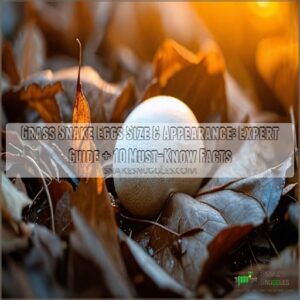 Grass snake eggs, about the size of a small candy bar, measure one to two inches in length and have a smooth, oblong shape.
Grass snake eggs, about the size of a small candy bar, measure one to two inches in length and have a smooth, oblong shape.
Their clean white color and leathery texture make them look like nature’s perfect little marshmallows.
Nestled in rotting vegetation, which acts like a natural cozy blanket, these eggs incubate safely, thanks to the warmth and protection from predators.
Unfortunately, with habitat loss on the rise, larger grass snake eggs are becoming rare treasures.
Did you know these eggs have unique adaptations for cold weather?
Stick around for more intriguing insights into their world and the threats they face.
Table Of Contents
- Key Takeaways
- Grass Snake Egg Facts
- What Do Grass Snake Eggs Look Like?
- Grass Snake Egg Incubation
- Grass Snake Egg Hatching
- Care of Grass Snake Eggs
- Threats to Grass Snake Eggs
- Grass Snake Egg Size and Appearance
- Are Grass Snake Eggs Better Than Live Young?
- How to Handle Grass Snake Eggs
- Grass Snake Egg Conservation
- Frequently Asked Questions (FAQs)
- How big do grass snake eggs get?
- When do grass snakes lay eggs?
- How long do grass snake eggs take to hatch?
- What do snake eggs look like?
- What are the facts about snake eggs?
- What is the size of snake eggs?
- How many eggs can grass snakes lay?
- Are snake eggs soft or hard?
- What predators threaten grass snake eggs?
- Do grass snake eggs emit any odor?
- How long can grass snake eggs survive without warmth?
- Are grass snake eggs sensitive to environmental changes?
- What is the impact of climate on grass snake reproduction?
- Conclusion
Key Takeaways
- You’ll find grass snake eggs are about the size of a small grape, measuring 25-35mm in length, with a smooth, leathery, creamy white to pale yellow shell.
- Grass snakes, being oviparous, lay their eggs with leathery, permeable shells, allowing gas exchange and nutrient absorption to aid embryo development during egg formation. Grass snakes lay their eggs in warm, decomposing vegetation which acts as a natural incubator, utilizing the heat generated by rotting plant matter.
- These eggs have unique adaptations for cold weather, with leathery shells that contain micropores to regulate moisture and temperature.
- Grass snake eggs face threats from predators like badgers and foxes, and are also impacted by human activities such as habitat destruction and garden maintenance.
Grass Snake Egg Facts
You’ll find grass snake eggs fascinating, as these leathery white ovals are about the size of your thumb and often hidden in nature’s perfect incubator – rotting vegetation.
Whether you’re a wildlife enthusiast or just curious, understanding these eggs’ characteristics will help you identify and protect these remarkable reptilian treasures in your local ecosystem.
What is The Size of a Grass Snake Egg?
Most grass snake eggs measure between 25-30mm in length, roughly the size of a small grape.
You’ll find they weigh about 5-7 grams each, making them surprisingly light for their size.
Female grass snakes typically lay clutches of 8-40 eggs, though the exact number depends on the mother’s size and health, which can be influenced by factors such as proper nutrition and a controlled environment, as discussed in a detailed snake breeding guide for beginners.
They’re particularly larger than many other European snake species’ eggs. As some oviparous snakes, like ball pythons, have adaptations for nesting and incubation, and lay a consistent number of eggs per clutch, which varies widely among species Snake Clutch Sizes. They’re particularly larger than many other European snake species’ eggs.
How Do You Identify Snake Eggs?
Looking at snake eggs might seem tricky at first, especially since some species, like rattlesnakes, are ovoviviparous snake facts, but identifying grass snake eggs is straightforward once you know what to look for.
They’re oval-shaped, about the size of a small grape, with a leathery white shell that’s slightly flexible when fresh.
The shell texture is smooth but not glossy.
You’ll typically find them in clusters of 8-40 eggs, often nestled in compost heaps or rotting vegetation.
If you’re interested in learning more about products related to grass snake egg clusters, such as incubation supplies, you can find them online at grass snake egg clusters.
What Do Grass Snake Eggs Look Like?
You’ll spot a grass snake egg‘s distinctive appearance right away – it’s quite a sight to behold. These remarkable eggs have several key characteristics that set them apart:
- The eggs sport a leathery shell with a soft, pliable texture that’s similar to a well-worn baseball glove
- Their color ranges from creamy white to pale yellow, sometimes taking on a slight pearl-like sheen
- Each egg measures roughly 25-35mm in length, about the size of your thumb
- The shape is oval but slightly elongated, like a miniature rugby ball
One of the ways to differentiate grass snake eggs from other reptile eggs is by learning about the Snake Egg Characteristics, which often feature a smooth, leathery texture and are found in sheltered spots.
The shell’s flexible nature allows for some give, which helps protect the developing snake inside.
When you find these eggs, they’re usually nestled together in a clutch, with each egg lightly stuck to its neighbors – nature’s way of keeping the family together!
Grass Snake Egg Incubation
You’ll be amazed to learn that grass snakes don’t need fancy incubators.
They cleverly use nature’s own heating system: decomposing plant matter.
These resourceful reptiles lay their eggs in rotting vegetation piles.
The natural heat from decomposition keeps their precious eggs at just the right temperature for successful development.
Rotting Vegetation as an Incubator
Nature’s clever composting system serves as the perfect incubator for grass snake eggs.
Decomposing plant matter creates a cozy microclimate where microorganisms break down vegetation, generating heat through fungal growth and nutrient cycling.
This natural process maintains ideal temperatures between 21-28°C (70-82°F), while also providing the right humidity levels.
It’s like having a high-tech incubator, courtesy of Mother Nature herself.
Adaptations for Cold Weather
While rotting vegetation provides warmth, grass snake eggs have evolved remarkable cold-weather adaptations.
Their leathery shells contain micropores that regulate moisture and temperature, acting like tiny thermostats.
Similar to the ideal conditions maintained in corn snake egg incubation, where a temperature of 80-85°F is essential for development, these eggs can temporarily slow their development – a bit like hitting the snooze button on their biological clock.
This hibernation-like state helps them weather cold snaps until conditions improve for hatching.
Grass Snake Egg Hatching
You’ll find grass snake eggs hatching through a process involving an egg tooth, which is a crucial tool for breaking through the shell from within, as explained in the guide on snake egg hatching process. You’ll find grass snake eggs hatching between late August and early October, with timing that varies based on local weather conditions and nesting locations.
Grass snake eggs typically take 45-90 days to incubate, with ideal conditions like those found in the corn snake incubation guide, which also applies to other snake species. Grass snake eggs hatch between late August and early October.
The timing of hatching varies based on local weather conditions and nesting locations.
If you’re lucky enough to spot the big moment, you’ll see these remarkable reptiles use their egg tooth to crack through their leathery shells, emerging as fully independent 7-inch hatchlings ready to take on the world.
Hatching Season
After incubation wraps up, grass snake eggs typically hatch between late August and early September in most European regions.
Think of it as nature’s back-to-school season for these little reptiles!
Here’s what happens during hatching season:
- Hatchlings use a special "egg tooth" to break through their shell
- They emerge fully independent, ready to hunt
- Most emerge within 24 hours of their clutchmates
Variation in Hatching Dates
Hatching dates for grass snake eggs can swing widely based on several factors.
You’ll find that climate plays a major role – warmer regions see earlier hatching, while cooler spots might delay it by weeks.
You can find products online related to grass snake egg care.
The nest site‘s location, individual variation between females, and food availability during the laying period all influence timing.
Surprisingly, eggs from the same clutch don’t always hatch simultaneously.
Care of Grass Snake Eggs
You’ll find that caring for grass snake eggs isn’t rocket science, but it does require attention to maintaining the right temperature and humidity levels in their environment.
Just like your morning cup of coffee needs the perfect brewing conditions, these eggs need a cozy spot in decomposing vegetation, staying at a steady 21-28°C (70-82°F) throughout their development.
Providing a Safe Environment
You’ll find grass snake eggs nestled in nature’s perfect incubator: compost heaps and piles of decaying leaves.
To keep these precious eggs safe, it’s important to maintain a good environment, especially considering the temperature greatly impacts incubation.
To achieve this, create a barrier around nesting sites using chicken wire – it’s like building a tiny fortress against hungry predators.
Just remember to leave enough space for mother snakes to come and go freely.
Think of it as setting up a cozy nursery in your garden.
Maintaining Humidity and Temperature
Grass snake eggs require precise environmental conditions to thrive.
The ideal humidity should hover between 80-90%, while temperatures need to stay steady at 25-28°C (77-82°F).
Think of it like maintaining a cozy spa day – you’ll want to mist the substrate daily and monitor both temp and moisture with digital gauges.
Small fluctuations are normal, but sudden changes can spell trouble for developing embryos.
Threats to Grass Snake Eggs
You’ll find that grass snake eggs face quite a few challenges in the wild, from sneaky predators like badgers and foxes to accidental destruction by humans clearing garden waste.
While these prehistoric-looking eggs are naturally tough, they’re especially vulnerable during their incubation period when they’re nestled in those cozy compost heaps we humans love to disturb.
Natural Predators and Threats
Even with careful egg care, nature throws some tough challenges at grass snake eggs. Think of them as nature’s version of a treasure hunt – everyone wants to find them!
Here’s what keeps grass snake parents up at night:
- Hungry badgers digging through leaf litter
- Foxes sniffing out hidden nests
- Crows and magpies swooping down for a quick snack
- Insects and fungi working their way into damaged eggs
Natural predators are particularly active during warm spells, when eggs give off stronger scents.
Human Impact on Grass Snakes
While natural predators pose challenges, human activities create far greater threats to grass snake populations.
Habitat loss from urban development pushes these reptiles from their nesting sites, while pesticide use decimates their amphibian prey.
Road mortality claims countless lives during breeding season, and the illegal pet trade removes eggs from the wild.
Garden "tidying" often destroys important egg-laying sites in compost heaps.
Grass Snake Egg Size and Appearance
You’ll find grass snake eggs are quite distinct from other snake species, with their leathery shells measuring about the size of a small chicken egg.
These fascinating oval treasures appear white or cream-colored when first laid, and you can often spot them nestled in rotting vegetation or compost heaps where they’ll stay warm until hatching.
Comparison to Other Snake Eggs
Among snake eggs found in Europe, grass snake eggs stand out due to their distinctive proportions. You’ll notice they’re remarkably different from their reptilian cousins when comparing key features:
- Larger than adder eggs at 25-35mm length
- More oval-shaped than smooth snake eggs
- Softer, more leathery shell than most European snakes
- Typically laid in clusters of 8-40 eggs
- Whiter coloration compared to yellowish viper eggs
Unique Characteristics
Grass snake eggs stand out like pearls in nature’s jewelry box with their distinctive leathery shells and oval shape, which is a common trait among oviparous snakes that lay eggs with shells.
You’ll notice they’re remarkably flexible, unlike typical bird eggs, which helps protect them from damage in their compost heap homes.
Their size ranges from 25-35mm, roughly the size of a quail egg, and they often develop a slight yellow tint as hatching approaches.
Are Grass Snake Eggs Better Than Live Young?
You’ll find that egg-laying isn’t necessarily better than live birth in snakes, as both strategies have evolved to suit different species and environments.
While grass snakes have mastered the art of laying eggs in warm, decomposing vegetation that acts like a natural incubator, this approach comes with its own set of challenges and advantages that we’ll explore.
Advantages of Egg-Laying
Having evolved a remarkable survival strategy, egg-laying gives grass snakes an edge in reproduction.
You’ll notice how this approach lets females deposit their clutches in warm, protected spots like compost heaps, then move on to feed and recover.
It’s nature’s way of spreading the risk – each female can lay up to 40 eggs in different locations, increasing the chances of successful offspring survival.
Disadvantages of Egg-Laying
While egg-laying offers independence, it comes with clear downsides.
Snake eggs face higher vulnerability to predation, with no parental protection during their 6-8 week development.
Environmental risks like temperature fluctuations and flooding can destroy entire clutches.
Limited care means hatchling survival rates are lower compared to live-bearing species.
Plus, females must find specific conditions for successful incubation, which isn’t always guaranteed in changing landscapes.
How to Handle Grass Snake Eggs
If you’ve discovered grass snake eggs in your garden or compost heap, you’ll need to handle them with extra care to avoid damaging their delicate shells.
While these leathery eggs are surprisingly resilient, they’re still vulnerable to temperature changes and physical damage, so you’ll want to follow proper handling techniques to keep them safe.
Safety Precautions
Similar to milk snake egg laying, handling grass snake eggs requires care.
Imagine eggs as delicate as your grandma’s best china.
Handling them with care can prevent a disaster.
Here’s a quick guide:
- Wear gloves to avoid transferring oils.
- Keep a respectful distance to prevent stress.
- Use gentle, steady hands like a pro surgeon.
- Identify any movement cautiously to check their status.
Avoiding Damage to The Eggs
Avoiding damage to grass snake eggs takes a gentle touch, much like handling a delicate soufflé.
Always use clean hands or gloves to prevent Nest disturbance.
Here’s a handy table for quick handling tips:
| Handling Precaution | Reason | Outcome |
|---|---|---|
| Use gentle touch | Prevents cracking | Minimizes risk |
| Wear gloves | Reduces contamination | Keeps eggs safe |
| Avoid quick moves | Prevents stress on eggs | Ensures safety |
| Check surroundings | Detect predators easily | Peace of mind |
| Leave in place | Minimizes human impact | Best protection |
Remember, small actions make a big difference.
Grass Snake Egg Conservation
Conserving grass snake eggs means protecting their habitats and ensuring their prey thrives, which is no small task.
You can help by reducing your ecological footprint, making a world where these eggs have a brighter future.
Protecting Habitats and Prey
Ensuring grass snake habitats thrive often means diving into amphibian conservation.
Think of wetlands as their lively home where prey and predators coexist.
You can also support conservation efforts by collecting items like a grass snake egg nest care kit, available at Grass Snake Egg Nest, to help you better understand their needs.
Habitat restoration is like revamping a neighborhood—keeping water pollution at bay and tackling invasive species.
You’re the guardian, nurturing this balance.
Remember, a healthy habitat is a bustling marketplace, not a hostile wasteland.
Reducing Human Impact on Grass Snakes
Let’s work together to protect these amazing creatures!
We can chip away at the problem by doing these three things:
1. Supporting habitat conservation efforts,
2. Practicing sustainable agriculture to reduce pesticide runoff (that harms their prey!), and
3. advocating for better road safety measures near their habitats.
Even small actions make a big difference for grass snakes.
Frequently Asked Questions (FAQs)
How big do grass snake eggs get?
Grass snake eggs are about 1 to 5 inches long and soft to the touch, like a tiny balloon.
They’re laid in warm spots like compost heaps, which help speed up development, much like nature’s little incubator.
When do grass snakes lay eggs?
Curious when these slithery creatures get to business?
Grass snakes lay their eggs in late spring to early summer, usually in compost heaps or rotting vegetation, using the warmth to incubate the eggs for about two months.
How long do grass snake eggs take to hatch?
You’re probably wondering how long it takes for grass snake eggs to hatch.
Typically, they hatch after about 10 weeks, depending on temperature.
Warmer conditions speed things up, so sunshine on a compost heap could be a bonus.
What do snake eggs look like?
Imagine finding a strangely leathery oblong treasure in your backyard—snake eggs!
These off-white, textured shells resemble tiny, flexible balloons.
Unlike bird eggs, they’re often laid in clusters, needing warmth from compost or rotting vegetation to hatch.
What are the facts about snake eggs?
Snake eggs vary wildly! Some are leathery, others are hard-shelled.
Size depends on the species, ranging from tiny to surprisingly large.
Many are white or cream-colored.
They’re usually laid in clutches, and the number of eggs varies greatly.
What is the size of snake eggs?
Ever wondered how big snake eggs are?
Typically, snake eggs, including those of the grass snake, measure around 1 to 2 inches long.
They’re leathery, not hard, so they can expand as the baby snake grows.
How many eggs can grass snakes lay?
Grass snakes can lay between 8 and 40 eggs per clutch, typically using warm, rotting vegetation piles as a natural incubator.
These egg clutches are laid in summer, ensuring the little ones hatch with independence in mind.
Are snake eggs soft or hard?
Crack an egg for breakfast and notice its hard shell; contrast that with snake eggs, which are soft, leathery, and slightly pliable.
This flexible design helps them absorb moisture, ensuring the developing snake gets a cozy environment.
What predators threaten grass snake eggs?
You might be surprised to learn that rodents, birds, and even other snakes love to munch on grass snake eggs.
These opportunistic predators find the eggs an easy snack, especially when they’re laid in open, vulnerable areas.
Do grass snake eggs emit any odor?
Imagine the scent of a moist forest floor.
Grass snake eggs don’t emit a noticeable odor.
Grass snake eggs are mainly nestled in compost or decomposing vegetation, which masks any scent, keeping the tiny treasures hidden from predators.
How long can grass snake eggs survive without warmth?
Grass snake eggs need consistent warmth to develop properly.
Without warmth, they mightn’t survive more than a few days.
If left cold, the embryos can perish or stall in development, highlighting the importance of their warm, protected environment.
Are grass snake eggs sensitive to environmental changes?
Yes, they are! Temperature fluctuations greatly impact their development. Too cold, and they’ll chill; too hot, and they might overheat. Humidity’s also key for successful hatching.
What is the impact of climate on grass snake reproduction?
A warming climate can hasten grass snakes’ reproductive cycles, leading to earlier egg laying.
Extreme temperatures and habitat shifts might threaten their survival.
These climate quirks can pose both advantages and risks to their future populations.
Conclusion
Did you know that grass snake eggs, with their marshmallow-like appearance, typically measure one to two inches long?
These eggs are fascinating, adapting to cool climates by snuggling into rotting vegetation’s warmth.
Understanding their size and appearance helps protect these rare treasures as habitat loss threatens their survival.
By learning about grass snake eggs’ unique features, you can appreciate their role in nature and contribute to preserving their delicate balance and future.

